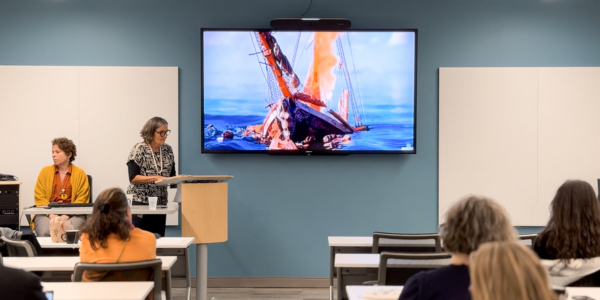
At a recent lecture hosted by the Center for Latin American Studies, Brazilian historian Martha Abreu wove together archival evidence, local memory, and transatlantic tragedy to tell the story of one ship, one community, and the broader legacy of illegal slavery in Brazil.
Abreu described the history of the Camargo, an illegal slave ship sunk off the coast of Brazil in 1852 to avoid capture. Not found until 2024, the discovery of the Camargo marks a significant milestone in the study of the transatlantic slave trade. But the talk wasn’t just about the ship—it was about the people tied to it, then and now.
Abreu’s lecture, In Search of Ship Camargo: The Quilombo of Bracuí and Historical Research of Slavery in Brasil, traced the ship’s role in Brazil’s complex and often buried history of slavery. Though the transatlantic slave trade had been outlawed in Brazil in 1831—and again more forcefully in 1850—the Camargo sailed anyway, transporting enslaved Africans under the cover of darkness and against the law. When discovered, the traffickers set the ship on fire and sank it to destroy the evidence.
The discovery of the Camargo’s wreckage has profound implications, not only for historical scholarship but also for the descendants of those directly affected. As Abreu explained, “They are still there, and we know that the history, and memories, and all the links that they have, and all that’s still important for them to stay there.”
The lecture also highlighted the collaborative project Passados Presentes, where Abreu connected with historian Keila Grinberg and others to explore how communities preserve memory, resist erasure, and claim ownership of their histories. Grinberg, who introduced the talk, spoke about how engagement and historical storytelling can deepen public understanding. “It’s not just about uncovering the past,” she noted. “It’s about who’s telling the story—and why it still matters.”
For many attendees, the lecture connected the dots between global histories of slavery and the enduring legacies of resistance and remembrance.
“Hearing about Bracuí reminded me of the exhibit I saw at the National Museum of African American History & Culture—how communities have fought to preserve their histories even when those stories were meant to be erased,” said Tatiana Limoncic, a student who recently visited the In Slavery’s Wake exhibit.
Grinberg echoed that sentiment, emphasizing the importance of cross-disciplinary, community-rooted work. “Events like these show how academic research can also be a form of justice—uncovering what was meant to stay hidden.”
For Abreu, the search for the Camargo is more than an archaeological mission—it’s a fight for visibility. “The ship is proof of the crime,” she said, “and it gives visibility to a tragedy that the community has survived through.”
Written by Emilee Ruhland, Pitt Global Communications
Photography by Nick Schmidt

